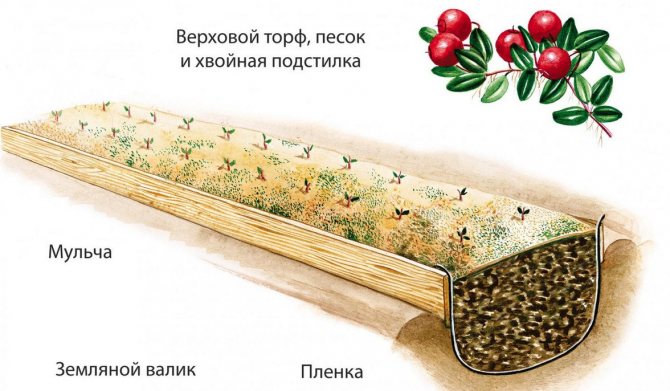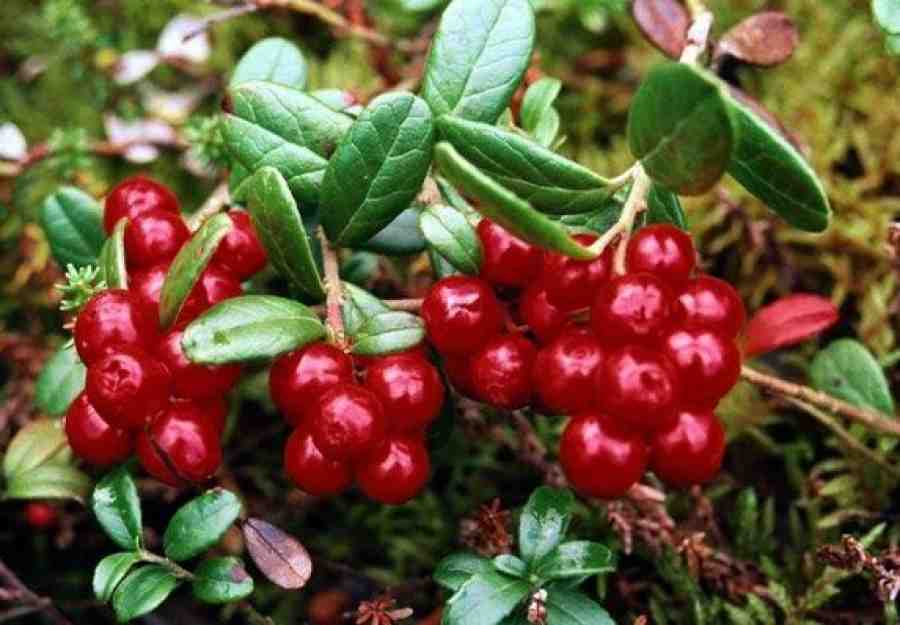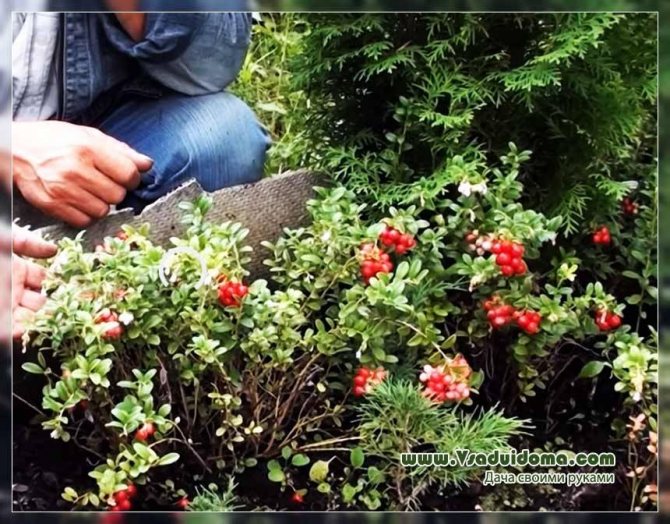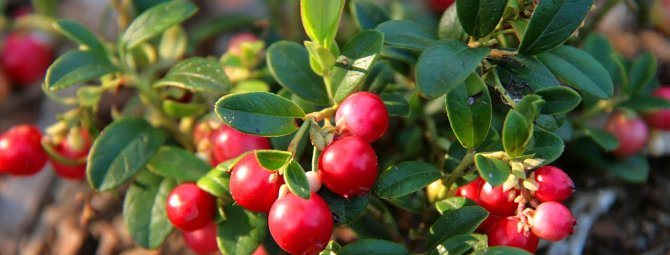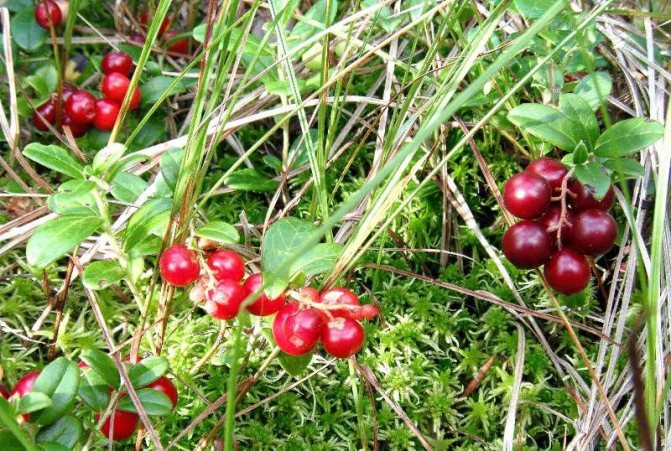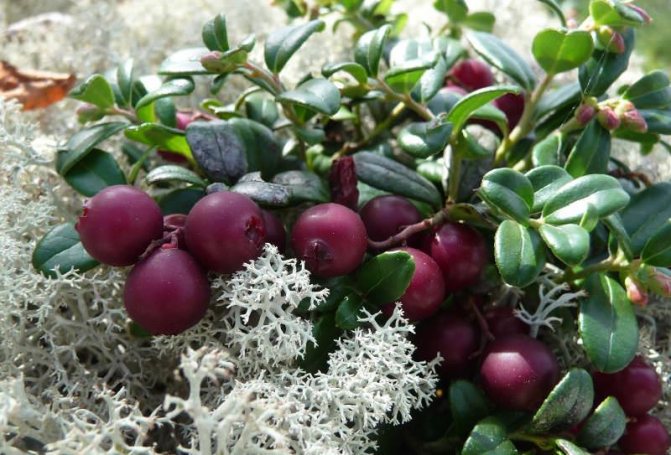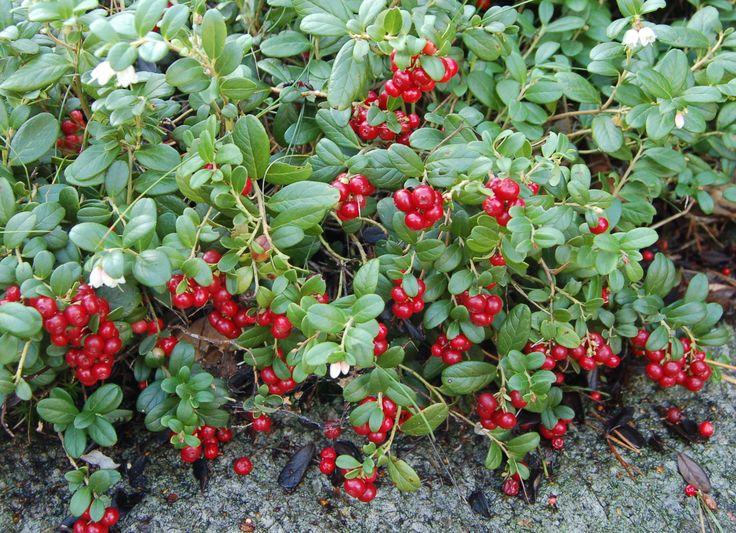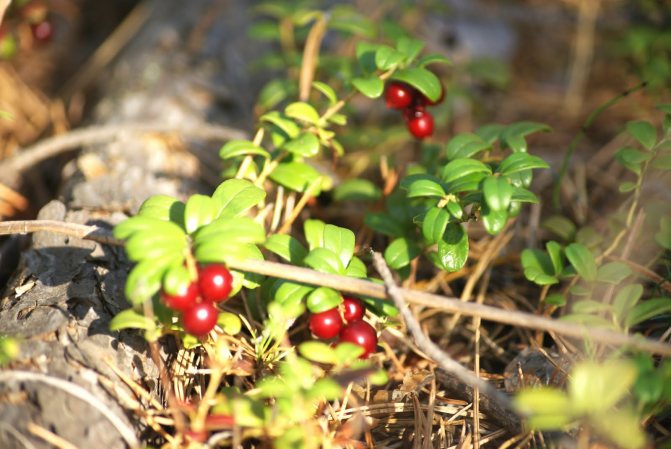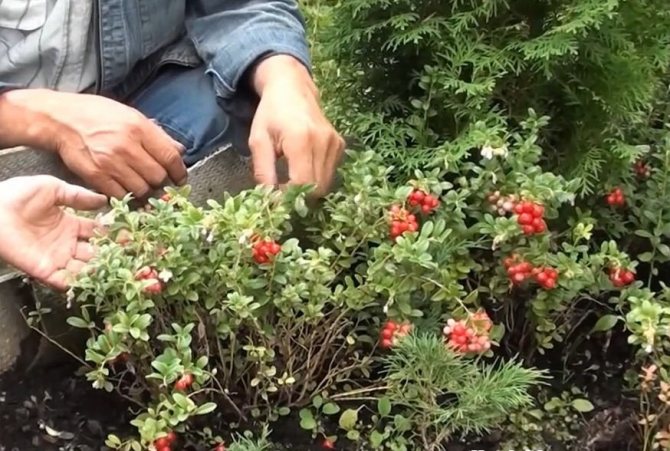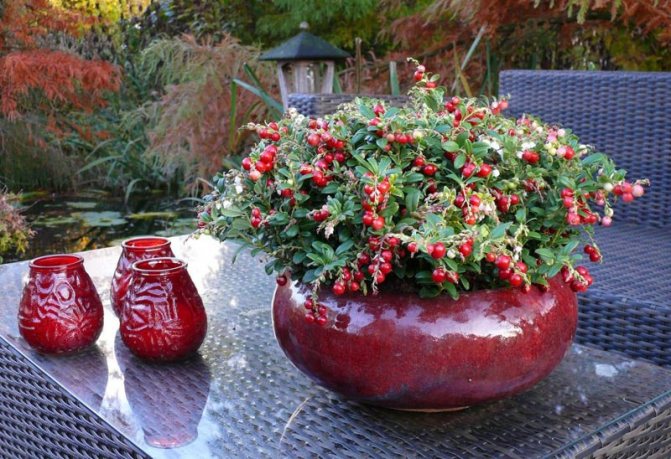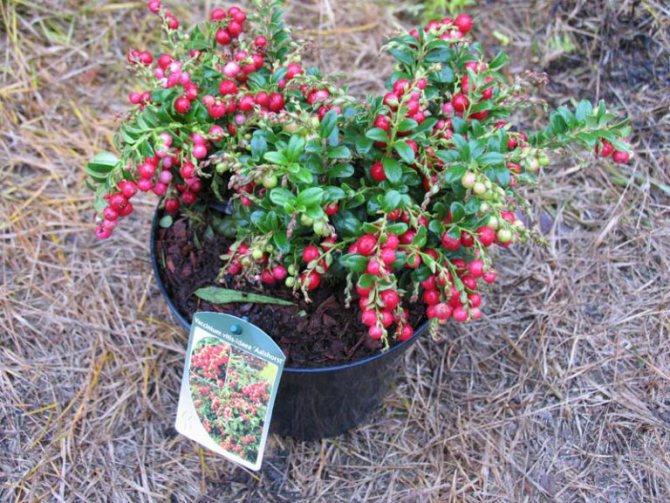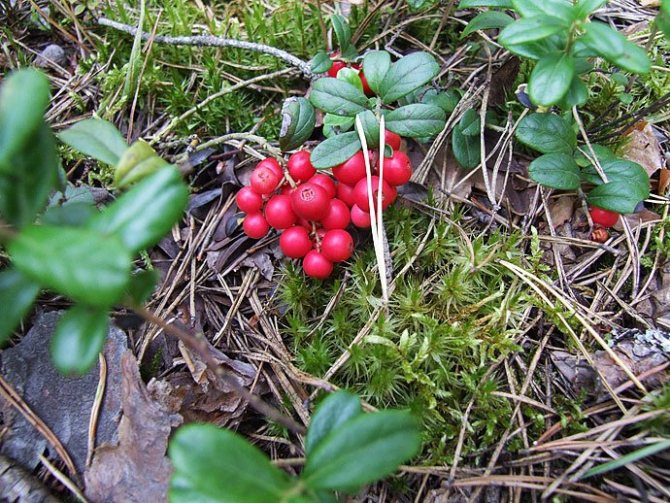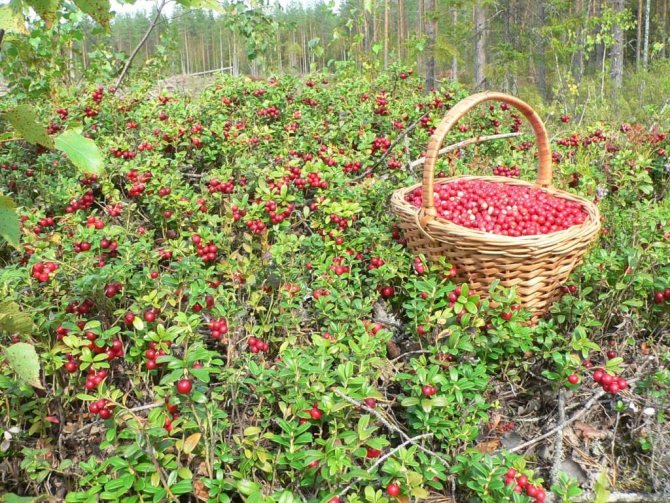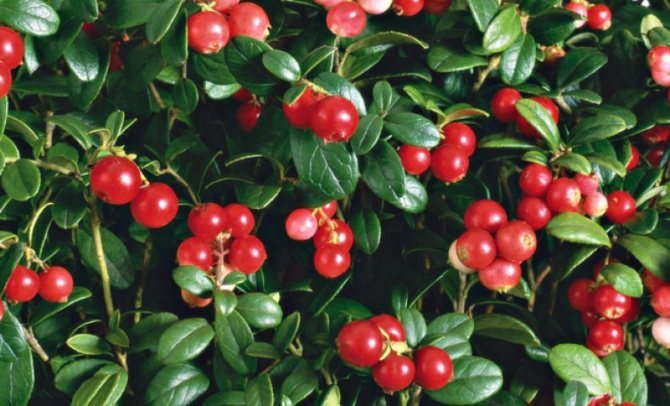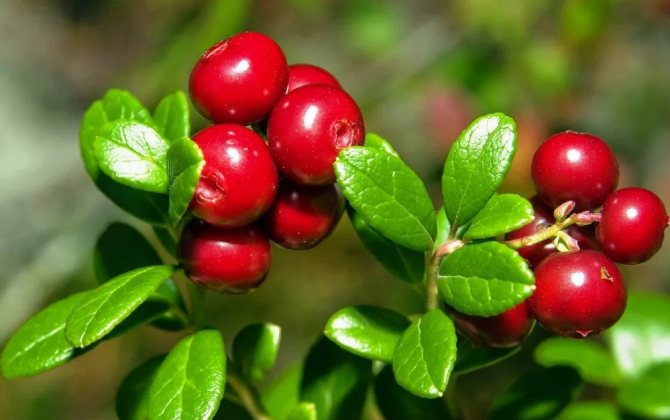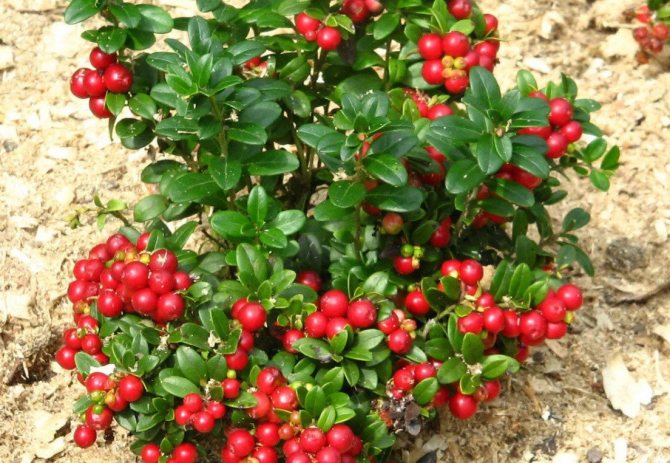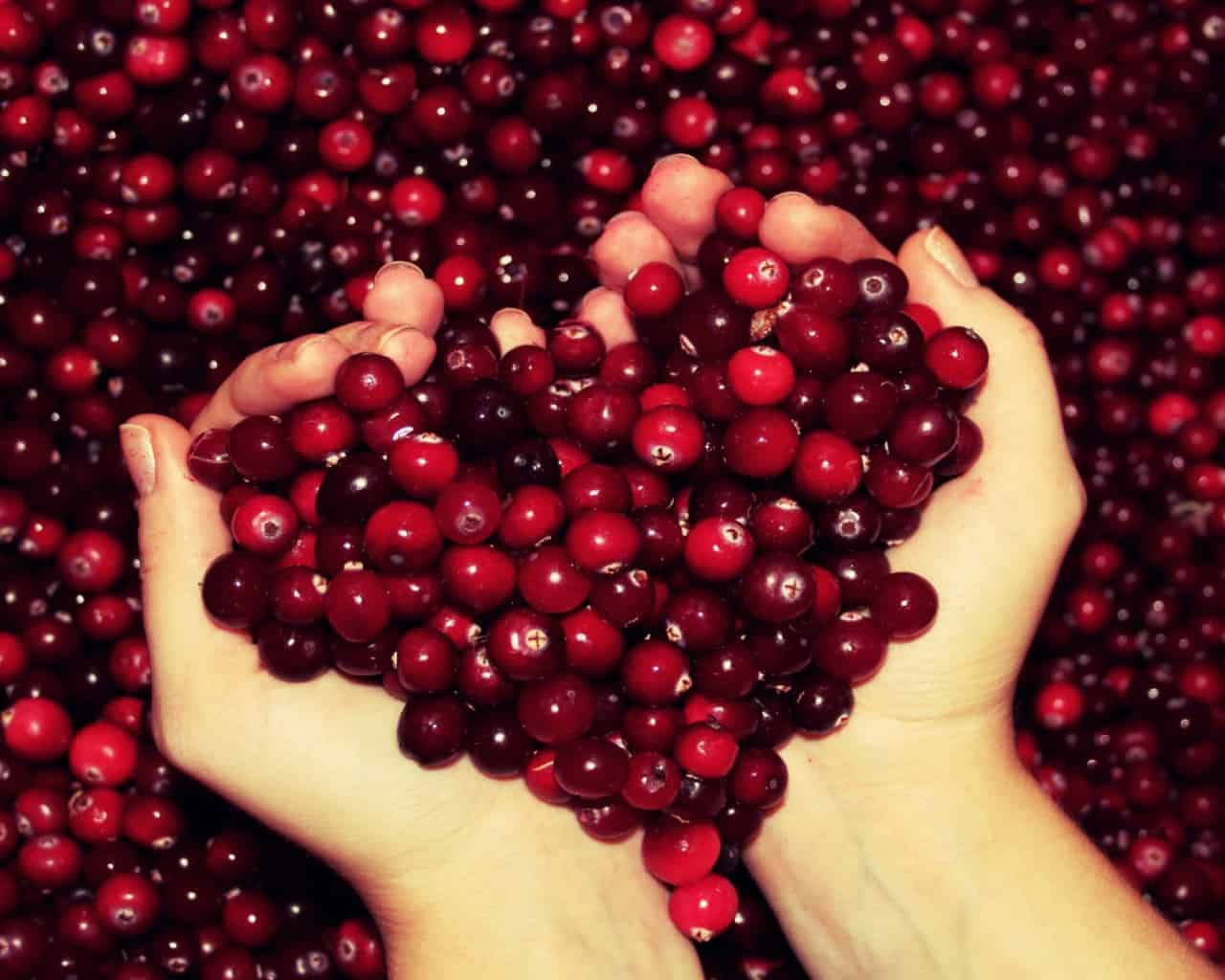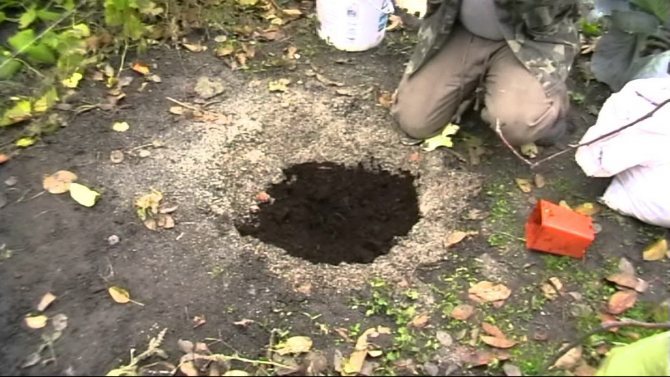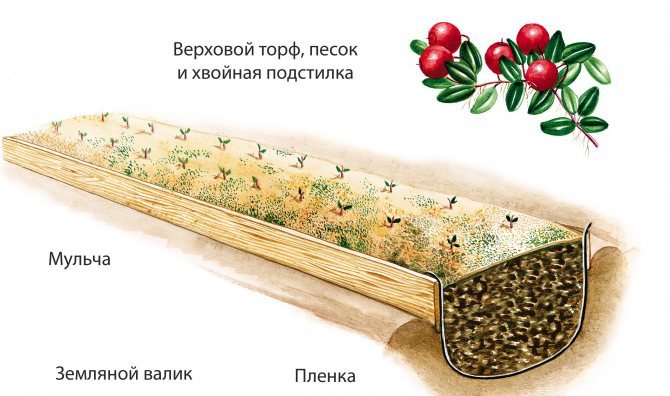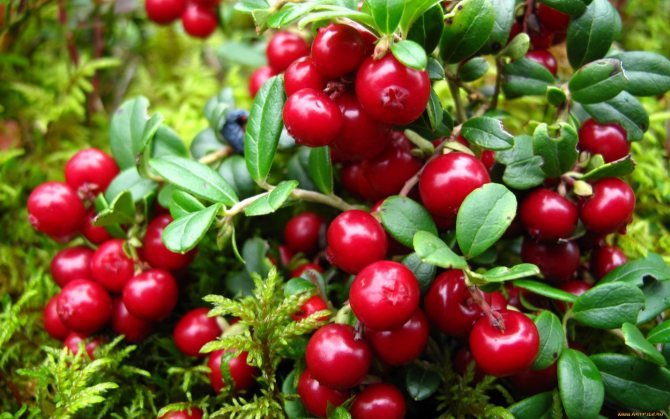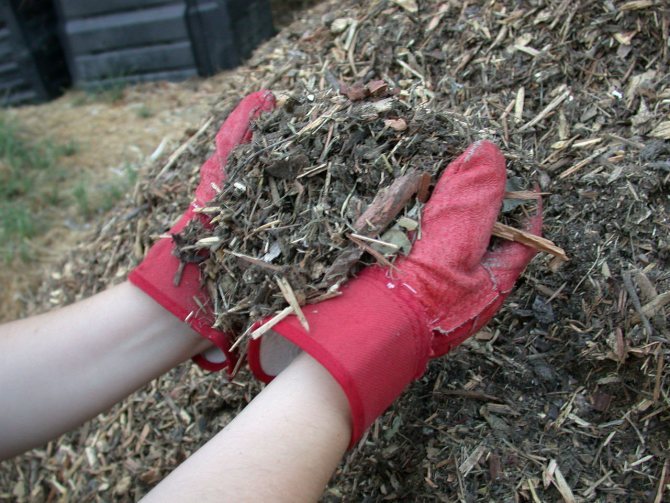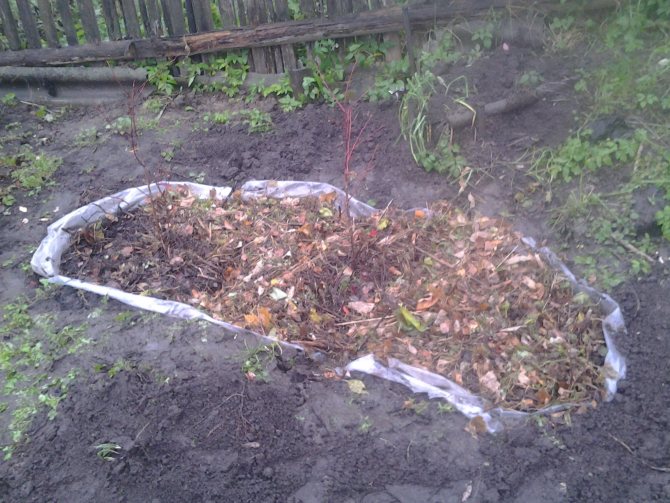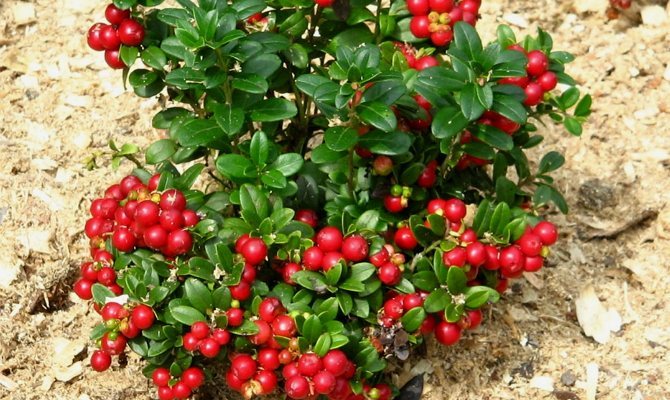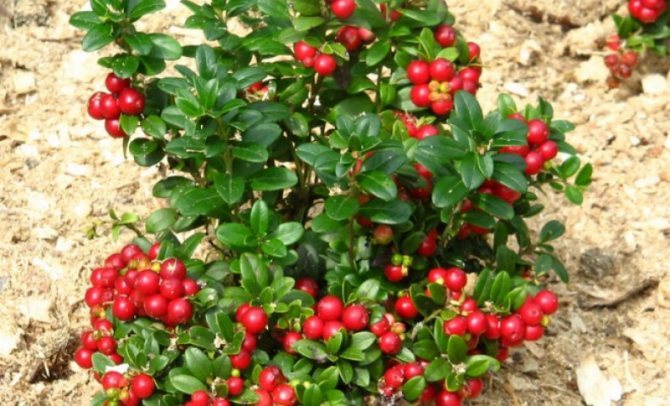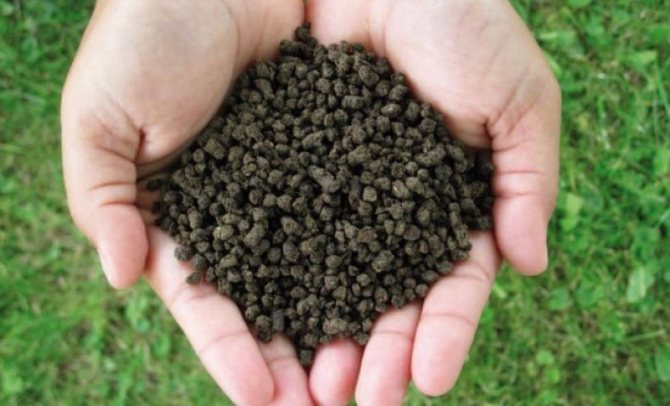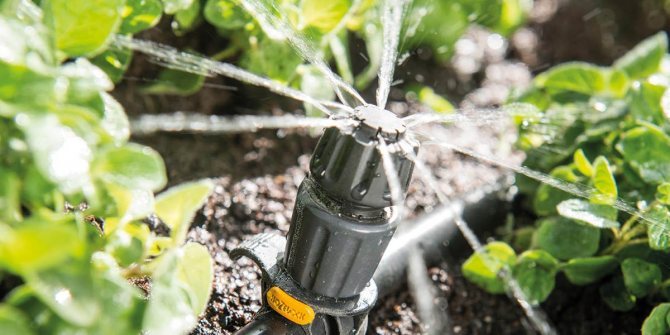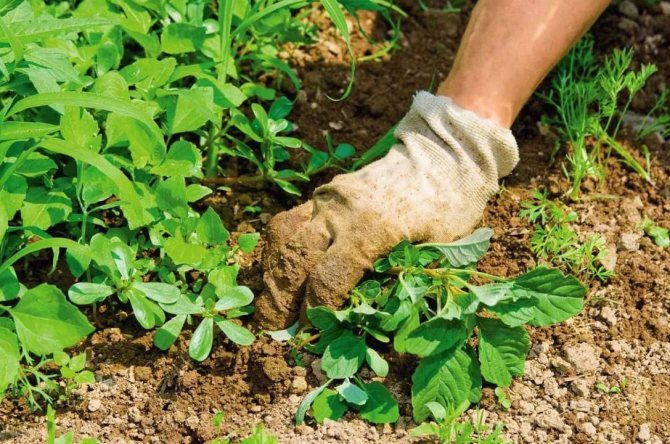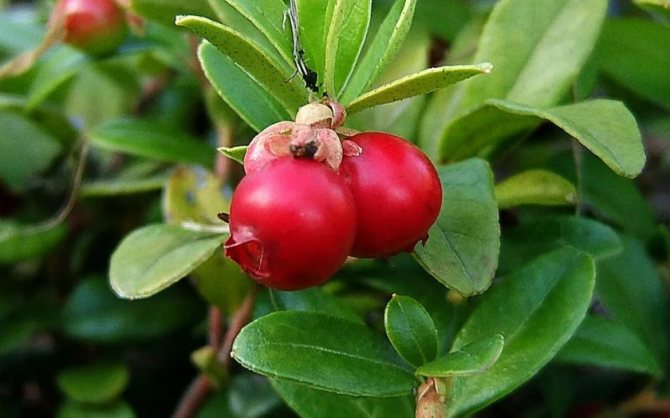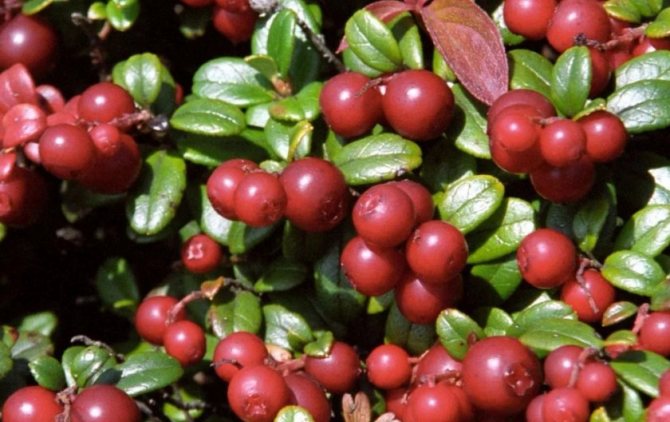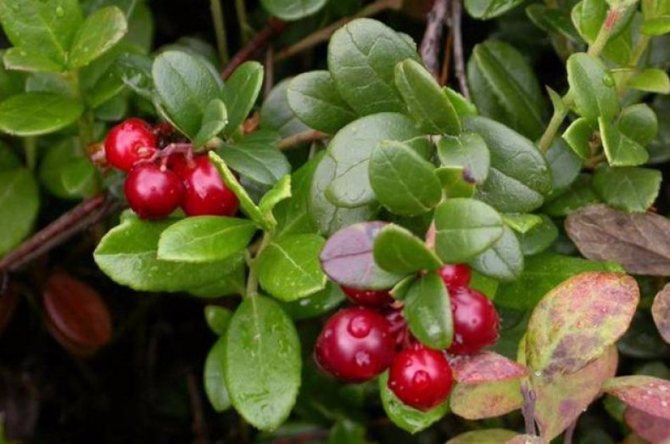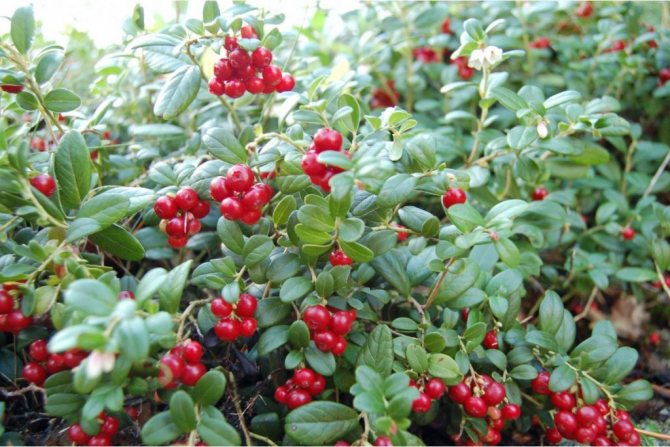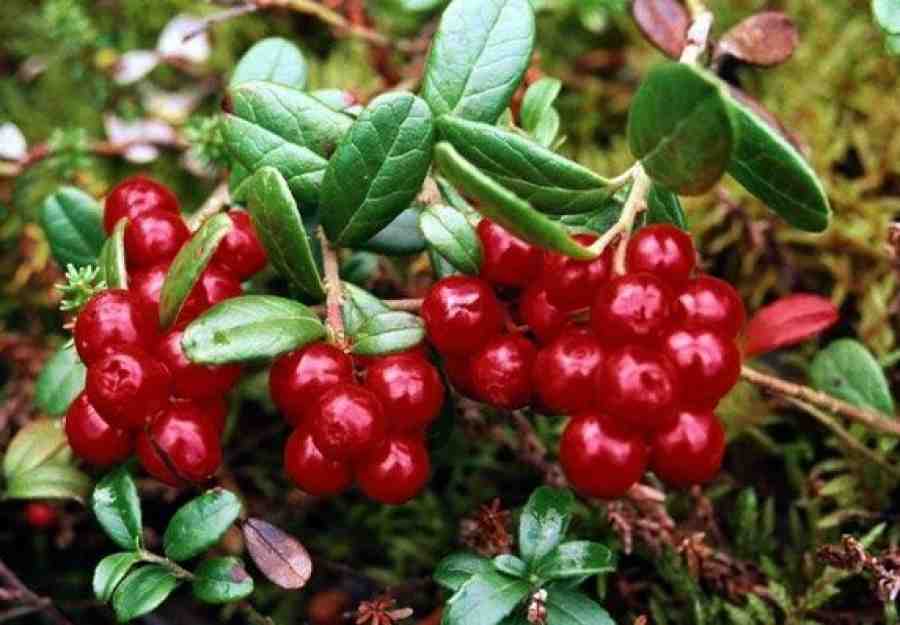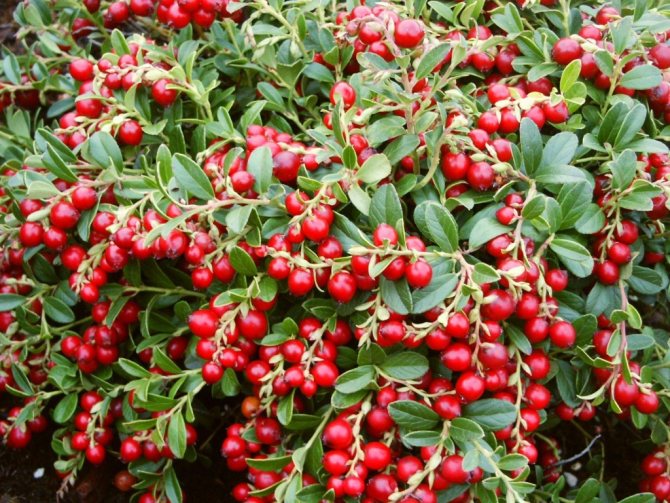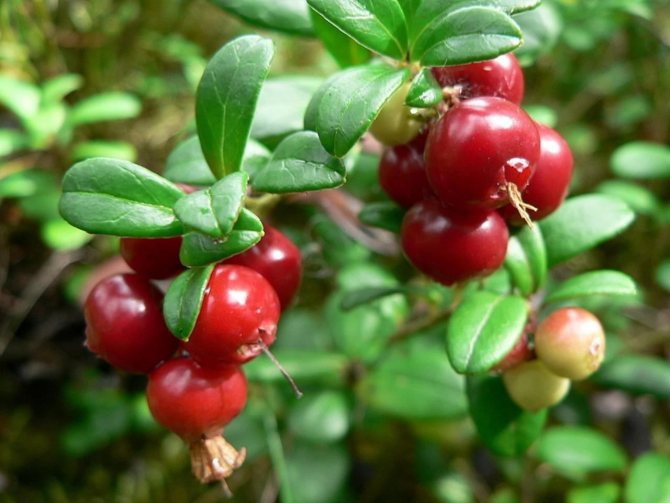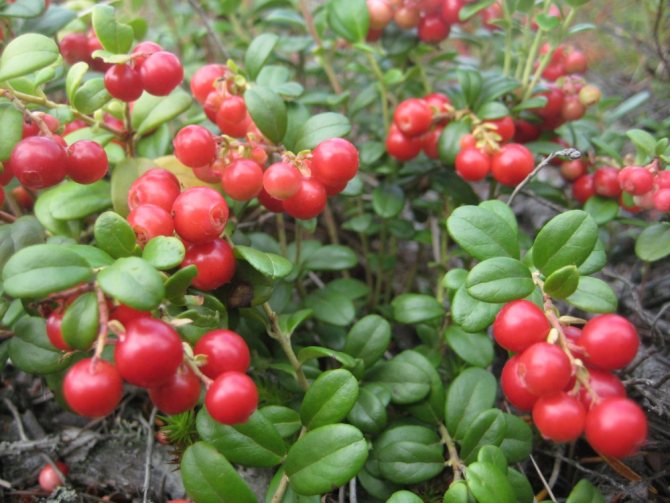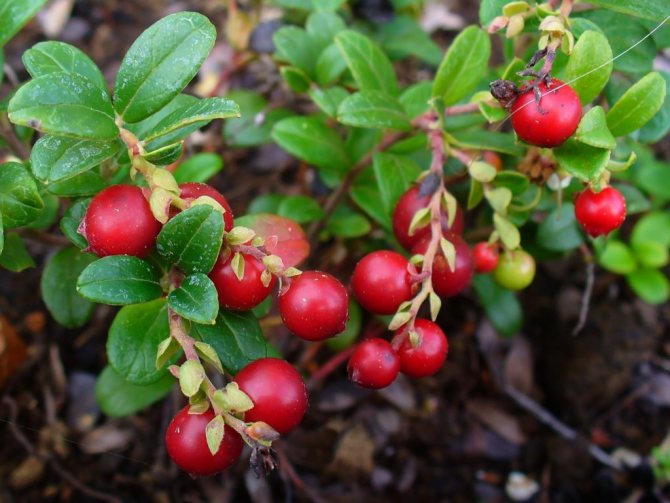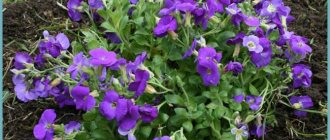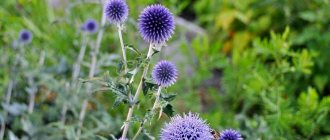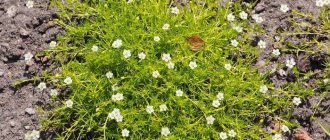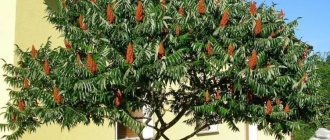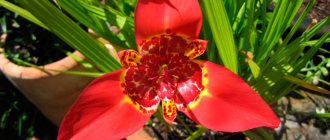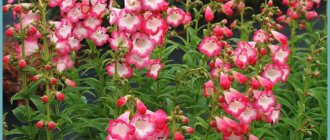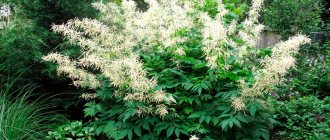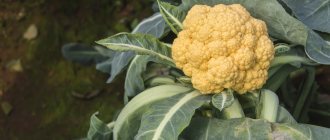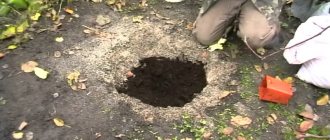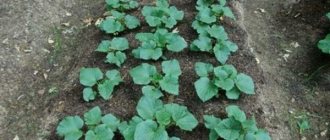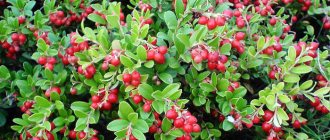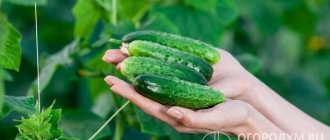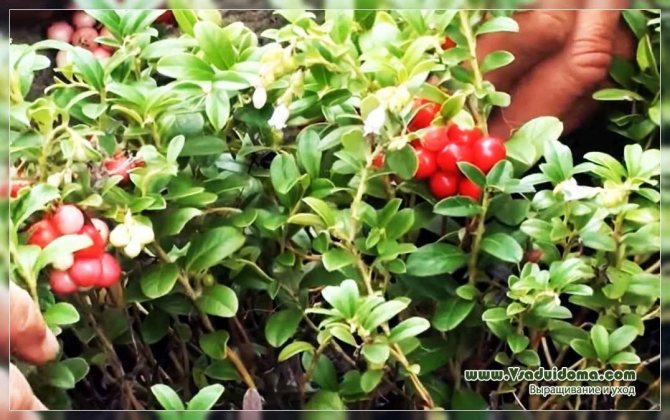
More recently, some 50, maybe 70 years ago, about how to grow their own lingonberries on a home plot and no one thought. This was partly helped by the breeders and, of course, the human demand for this useful berry.
In general, lingonberry belongs to those crops, the care of which is extremely simple. The main thing is to give it "its place", to protect it, and on this site it will grow, turning into a real lingonberry, from which you can pick berries, as if you are in the taiga or forest-steppe zone - the favorite natural places of lingonberry growth.
By itself, lingonberry (suddenly, who does not know) is a perennial plant, low, evergreen (leaves in winter with leaves, and this is not a miracle, blackberries do the same), which is a semi-shrub with very fleshy and juicy leaf blades and reaching a height of two with a little tens of centimeters.
Lingonberry got its Russian name for the red color of the fruit, then, in the old days, it was called "lingonberry". That's all, no secrets and mysteries.
During the flowering period of lingonberries, you can see, albeit small, but cute to the eye whitish-pinkish flowers, well, later (towards the end of summer) berries appear, sweet and sour, not everyone's respected taste.
Growing lingonberries in the country
lingonberry cultivation
In the spring, lingonberries first grow flower brushes, and only then young shoots grow. Flowering usually occurs in the Moscow region in May, in some years it continues in the 1st decade of June.
Miniature white bell-shaped flowers are collected in clusters of 4-8 pieces. But on one branch, several brushes can be located side by side, and the total number of flowers reaches 20, sometimes up to 40. Lingonberry flowers bloom in a strict sequence from the base of the brush to its top.
Flowering of one cluster usually lasts only 1-2 days, and the total duration of flowering is about three weeks. The main pollinators are bumblebees.
How to plant seedlings in open ground
It is possible to plant lingonberries in open ground in the spring, starting in April, when the weather is stable, and also in the fall before the first frosts appear. Moreover, in spring, young plants are most often covered with non-woven materials to protect them from possible frost.
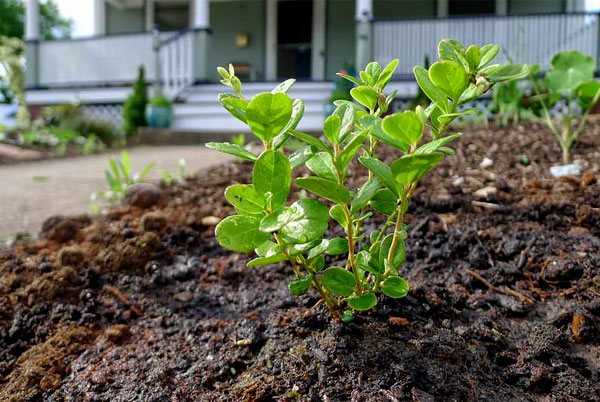

It is advisable to plant lingonberries after the average daily temperature is stable above + 5 ° С
It is best to use seedlings 2-3 years old for planting. They almost always take root and begin to bear fruit faster. Saplings are planted in the beds along with the soil in which they grew. For this, as a rule, depressions of 12-15 cm are made in the ground. Seedlings, carefully removed from a pot or box, are lowered into them. Then the earth is slightly tamped, filling the top layer of soil in which the bush grew, with soil from the garden. Small lingonberry cuttings are planted in the same way, but they are buried in the soil only 2-4 cm.
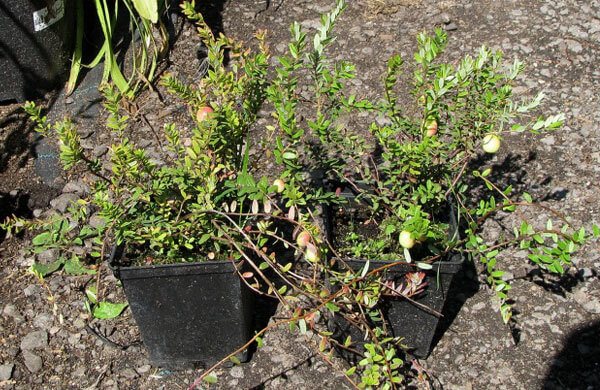

When planting from pots, the bushes are transferred directly with a clod of earth.
When planting seedlings, it is necessary to leave a sufficient distance between them. The bushes should be 25 cm apart as they will grow. In addition, after a few years, as a result of natural division, young bushes may appear nearby.
After planting lingonberries, it is imperative to mulch the soil. You can use softwood sawdust, straw or small gravel for this. They are laid out on top of the ground in a layer of 2 to 5 cm. Mulch helps to retain the necessary moisture, and sawdust and needles help acidify the soil.
According to gardeners, for the first 10 days, lingonberries need to be watered every day, and then as needed. For irrigation, it is advisable to use rainwater or settled for 1-2 days. For example, here is a video feedback about the autumn planting of lingonberries:
Soil preparation
The main condition for the successful growth of lingonberries is light, loose, acidic soil. From natural soils, raised and transitional peat bogs, sands and even sandy loam are suitable. But on sandy loam and sandy soils, the yield of lingonberry will be about half that on peat.
Lingonberries will not survive on clays. A complete replacement of the soil is necessary here. For lingonberries, soil mixtures of high and transitional peat with sand are good - 3: 1, 2: 1, and even 1: 1.
There is no need to dig deep holes for lingonberries, since their roots usually do not go deeper than 25 cm into the soil. Watering is necessary when planting.
Caring for lingonberries is not very different from caring for garden cranberries.
Lingonberries are difficult to compete with weeds, especially young plants, so regular weeding of plantings is necessary. It is good when it is combined with loosening.
In dry hot summers, lingonberries need watering. The best way to water is by sprinkling. Irrigation rates depend both on the conditions of the year and on the type of soil on which the shrub grows. On sands and sandy loams, watered more generously than on peat.
It is important not to forget that summer flooding is very dangerous for lingonberries. If there is a threat of stagnant water or flooding in the selected area, drainage must be carried out even before planting.
It is extremely useful to mulch lingonberries with high-moor peat, crushed bark, coniferous litter, especially when planting on sandy and sandy loam soil. These organic materials enrich the soil with nutrients, increase its moisture capacity and acidify it, while chicken manure, manure and compost cannot be used for this plant. Sand is also used as mulch on peat soil. It inhibits the growth of weeds, is useful against diseases and pests.
The shrub requires only minimal doses of mineral fertilizers. On sandy and sandy loam soils in the 1st year after planting, fertilizers are also not needed, on peat mineral fertilizers are not required at all. For the second year, an extremely low dose (1 g / m2) of fertilizer "Kemira Universal" is used. Over the time the shrub enters full fruiting (somewhere in the 3-4th year), they bring in 2-3 g / m2 annually? complex fertilizer "Kemira Osennee".
Lingonberry begins to bear fruit early, when propagated by green cuttings - in the 2-3rd year. The yield of cultivated lingonberries reaches 1 kg / m2.
Lingonberry branches can live for 10-15 years, but then they must be cut off in order to rejuvenate the bush. If pruning is carried out in time at a height of 4-7 cm from the soil surface, then the bush gives fresh new branches and can bear fruit again.
Use in landscaping
Lingonberry is rightly considered an excellent ornamental plant. It is beautiful all year round thanks to a compact bush with leathery shiny dark green leaves. In spring, the twigs are covered with snow-white bell-shaped, albeit small, but numerous flowers. Lingonberries are especially beautiful when the berries are ripening. It is stretched in this type of plant. Already in July, from the illuminated side, the berries gradually turn red. But full ripeness comes only in August.
As ornamental plants, preference should be given to Western European remontant varieties. Their re-flowering almost coincides with the maturation of the first crop.
Lingonberries can be successfully planted in rocky gardens.tall forms, especially Koralle, are good for low curbs. Lingonberries are also appropriate on an alpine slide, subject to planting on peat-containing soil and generous watering.
No less useful, especially for sight, is another forest, and now garden berry - how to grow garden blueberries.
Characteristics of culture
The plant has green shoots that retain their color even in winter. The bush is widespread in the wild, but it is very often grown by gardeners. Outwardly, the bush is small, blooms in late spring.
Decorative and useful properties
The plant can be grown in the garden among fruit trees. The culture is not demanding to care for and can tolerate low temperatures. Very often, lingonberries are grown in the country as decorations for a garden plot. The bushes have decorative qualities due to their green shoots and leaves, which retain their color even in winter.
Bushes with bright red berries, planted in a personal plot, also have an attractive appearance.
Garden lingonberry has the following beneficial qualities:
- accelerates the healing process after infectious diseases;
- used for cancer;
- used for colds;
- contains a large amount of vitamins and minerals necessary for the human body;
- lingonberry leaves have tannins;
- restores intestinal microflora;
- has a diuretic effect.
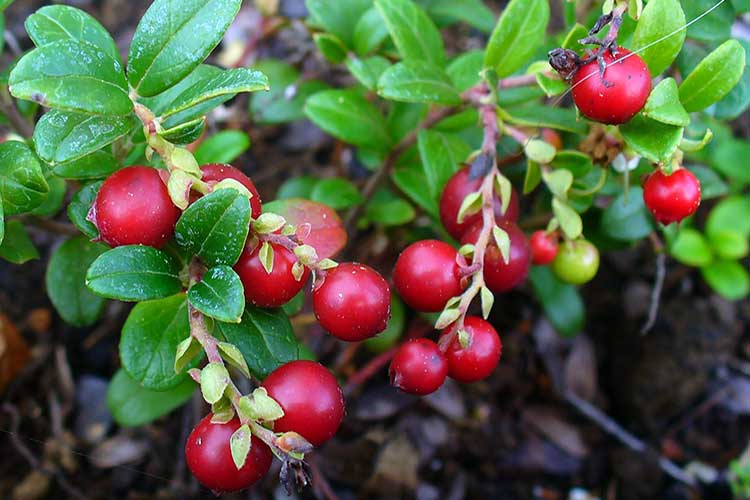

Eating lingonberries helps lower blood pressure. Also, regular consumption of berries can help normalize blood sugar levels.
Description and varieties
The culture belongs to the Heather family. The bush is small in size, the leaves are ovoid, dense, with a thick skin. Above, the leaf is green smooth, matte below. Inflorescences are white, outwardly reminiscent of small bells with a pleasant smell. After ripening, the fruits turn red and taste sweet and sour. They contain a large amount of seeds.
The plant is subdivided into two varieties - remontant, which yields twice a season. And ordinary garden ones, the ripening period of which is in the fall.
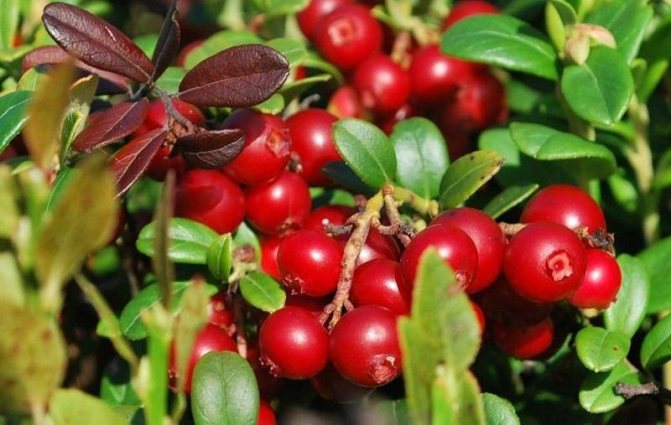

Garden lingonberry has the following popular varieties.
| Variety | Characteristic |
| Coral | The Coral variety is distinguished by its high decorative qualities. The bushes have long, curved shoots. The berries are large, dark red. From one bush, you can get up to 700 grams of the crop |
| Linnaeus | Bushes are small, spreading. A distinctive feature of the culture is the taste of berries, which contain a hint of bitterness. |
| Mazovia | Shrub culture, reaches a height of no more than 10 cm.It is rarely grown in the garden, more often used to cover the soil |
| Ruby | The plant has large berries. Bushes can reach large sizes, juicy red berries |
Shrub lingonberry is characterized by high frost resistance and is widely used for landscaping a garden plot.
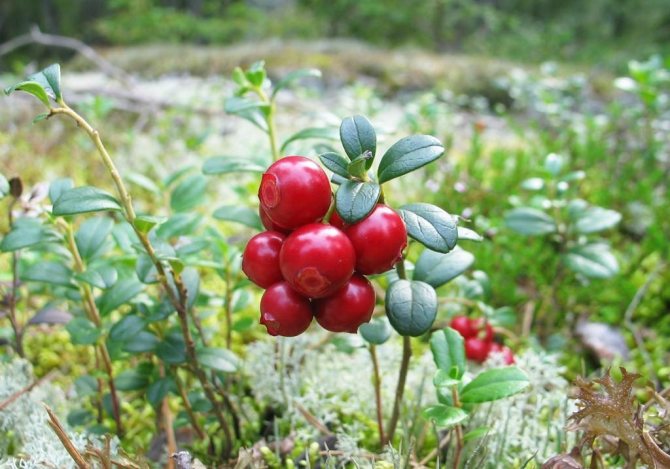

Cultivation area
It is recommended to grow garden lingonberries in places where the acidity of the soil is overestimated, since the habitual environment for plant growth is swampy areas. In different areas, it is necessary to observe the peculiarities of cultivation:
- Far East - the plant allows you to collect large yields, this is primarily due to the suitable climate and the absence of excessively low temperatures.
- Ural - in this region, garden bushes of culture are practically not grown. Lingonberry develops poorly, and the yield per plant is small.
- Ukraine - in this country, lingonberries are rarely grown, only if necessary. When planting, it is necessary to add additional acid to increase the acidity of the soil. It is also necessary to water regularly, as the plant prefers moist soil.
- The Moscow region and the middle zone of Russia - this region is well suited for growing garden lingonberries.
Depending on the region in which the crop is grown, it is necessary to cover the bushes before winter.
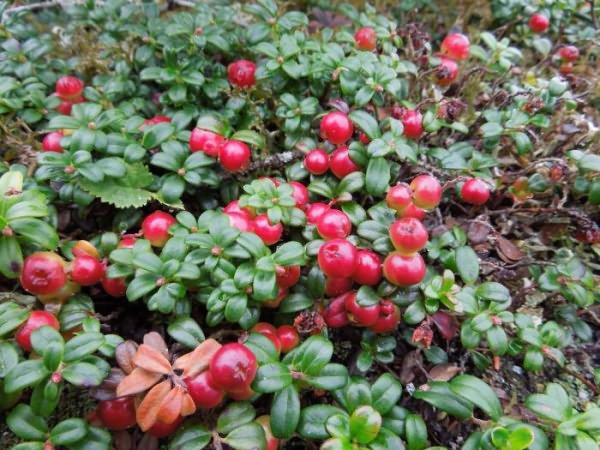

Necessary conditions for growing
To obtain a large harvest after planting lingonberries in the open field, the following conditions are necessary:
- the soil must be nutritious and contain a large amount of organic matter;
- in the area where the crop is grown, there should be no weeds that prevent the plant from developing correctly;
- you can grow a berry in moist soil or observing regular watering;
- in regions with an extremely cold climate, the plant must be covered for the winter.
See also
The composition of the soil for garden blueberries and how to prepare the soil with your own hands
To read
The culture is undemanding to care, if the correct planting site is chosen, it allows you to harvest a large harvest of useful berries.
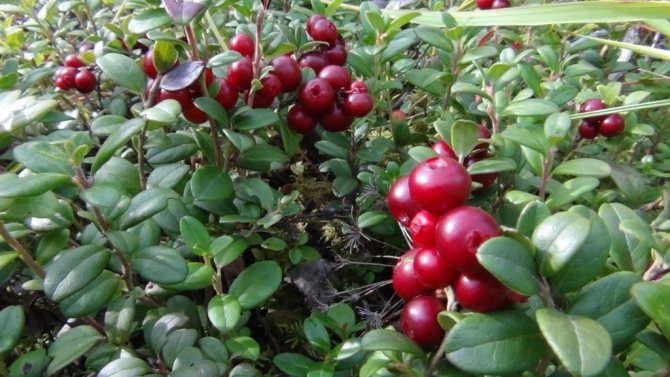

Growing lingonberries in the country: planting and care
Who would have thought that a low evergreen shrub with hard, glossy oval-shaped leaves and a pronounced midrib, with round red fruits, the diameter of which is from 3 to 12 mm, with a creeping rhizome, that is, lingonberry, could well grow in a summer cottage?
Natural growing conditions of lingonberry
Today we will talk about how to plant lingonberries in the country. The berry will delight the owners with a good harvest from mid-August to the end of September, if conditions are created for it that are as close to natural as possible. In a natural situation, the berry chooses places with acidic soils, lowlands with non-stagnant water and mountainous areas. She does not need rich fertile soils, her element is peat bogs, forests with conifers or a mixed structure, she can often be found on hummocks and banks of swamps.
Read also: Boric acid for plants: methods of application in the country
White and pink bell-shaped buds from 5 mm appear in May, inflorescences form brushes, numbering from 3 to 15 flowers with 8-10 stamens in each. It cannot be said unequivocally that the berries are red: depending on the degree of ripeness, they are colored pink, crimson and burgundy. Reproduction takes place with the help of shoots from the buds on the roots.
Geographical points of growth:
- some regions of Europe (Carpathians, Bulgaria, Serbia);
- Western and Eastern Siberia;
- North of the USA, East of Greenland;
- Caucasus, Altai;
- Novaya Zemlya, Sakhalin, Amur, etc.
Despite the fact that in the last quarter of the XX century the USA, Finland, Sweden and some other countries began to cultivate this breed, there are no large plantations for its cultivation anywhere. But Russian summer residents are growing it with success!
The main thing for lingonberries is to plant them in the right place!
Despite such a wide habitat, lingonberries will take root in the summer cottage, despite the absence of spruces, pines and swamps, if you prepare fenced ridges for it from a mixture of peat and sand. This is the optimal composition, mountains and stones are not at all necessary. It will be enough to have a flat area with non-stagnant water.
You can read more about the proportions of sand and peat, depending on the composition of the soil on which you are going to grow this crop, and you can read about the preparation of the trench here.
Among the features of the preparation of the site for the cultivation of lingonberries are as follows:
Planting lingonberry cuttings
Distance between cuttings in the nursery
The main planting activities include the marking of the plantation: the distance between adult bushes is 25-30 cm, between rows - 60 cm, the width of the ridge is 1.2 m. Up to this point, the cuttings grow throughout the year.
An adult bush during flowering and ripening
Correct care
We have already noted above that the soil for lingonberries is not black soil, and it is necessary to enrich all varieties of soil. Peat bog, well-rotted plant organic matter and mineral fertilizers are added for every 100 meters of the plantation in the following volumes:
- 5-6 m3 of peat bog;
- 7-8 kg of phosphate fertilizer;
- 4-6 kg of mineral-containing;
- obligatory acidic solutions (before planting and then - in a three-year turnover).
Solutions with vinegar, oxalic or citric acid, used car electrolyte (based on a half-liter can for 8 liters of settled water) increase the acidic reaction of the soil.
Lingonberries are planted at their summer cottage in October or spring. At this point, you need to pay attention to the fact that the rhizomes are buried 1.5 cm further than it was in the growing area.
Watering features
Summer residents should keep in mind that the time from planting to the beginning of fruiting can be 1-2 years. During this period, the main elements of top dressing should be nitrogen + phosphorus and potassium. More about the regime and composition of feeding lingonberry.
Protection against frost, weeds, disease and aging
In order for lingonberries in the country to bring a good harvest, in the northern regions they need protection from frost. It is best to do this by covering the plant with a layer of mulch before the beginning of winter (needles of coniferous trees, crushed bark, sawdust, the top layer brought from the forest, etc.), the thickness of the embankment is 2-4 cm. Such a "heater" should not contain weed roots.
Lovers of vitamins should know that the plant is not afraid of winter itself, but spring frosts at the moment when the berry will start its first buds. At this time, you can additionally cover the plant with burlap, polyethylene, spruce branches, foam rubber.
In a forest with an established ecosystem, the berry occupies an area free from large weeds. A summer resident will have to think about how to protect lingonberries from bindweed, wheatgrass and other terrible enemies, especially from their rhizomes. If you have obtained a sufficiently large area with lingonberries, it is possible to use a round. Here it will be important to comply with the recommended consumption rates. Owners of a small plot will have to puzzle themselves with immediate weeding.
Even with absolutely correct care, productivity may decrease after a while. To prevent this from happening, pruning is necessary. It is performed in early spring, cutting off a significant part of the old bush and leaving a "stump" with 4-6 leaves. What you cut should not be composted, given the medicinal properties of the branches, leaves and berries. Or, seedlings can be grown from the scraps.
Reward for labor
Lingonberry: description and features of the plant
For those who do not know, we will conduct a short course in biology.
Common lingonberry is very common in the tundra and forests of the northern part of our planet. She belongs to the Lingonberry family and the Lingonberry family. In Russia, lingonberry grows in the European part of the country, as well as in Siberia and the Far East; there are small areas of lingonberry in the middle lane.
Favorite growing areas of culture are secluded, with clean air, in appearance it is not as striking as raspberries or wild strawberries, but it also has a valuable set of various elements without these, the full existence of our species will be problematic.
- It is often permissible to meet this culture in not too dense mixed forests, on peat soils, where there was once a forest, or in places of former fires. Sometimes there are so many lingonberries that these places are called lingonberries.
- The plant is characterized by a dark greenish color of the leaf blade, pinkish-white flowers and berries, which usually ripen in August and have a mass of about 0.5-0.6 g and a rich red color.
- The taste of the fruit is pleasant, sweet-sour, with a slight bitter aftertaste.
- You can pick berries for a long time from the beginning of their ripening until the onset of frost.
In Russia, lingonberries are still not used as an industrial crop, berries are collected mainly in the natural habitat of lingonberries, it is clear that there simply cannot be enough natural reserves for everyone.
But not everything is so critical, because everyone knows that due to demand, supply is also born, which is why lingonberry planting material has recently begun to appear, its volumes, albeit at a slow pace, are growing every year. Of course, the main interest comes from the owners of plots located on the peat bogs - this is a desirable place for lingonberries.
The benefits of berries
Berries have high taste and medicinal properties, they are in constant demand on the market, it is not for nothing that lingonberries were introduced into the culture in the west a long time ago and are grown everywhere and very successfully. ______________________________________________
WHAT TREATS LINGERBERRY? ______________________________________________
What are the benefits of lingonberry? Of course, in its biochemical composition. For balance and acidity, the berries contain:
- glucose about 11.9%, pectin, tannins, a fairly large amount of P-active substances, as well as vitamin C, carotene,
- a whole bunch of other vitamins - E (vitamin of eternal youth), B2, B9,
- as well as glycosides, which are extremely necessary for a person, among which arbutin and vaccinin are in the lead, which, among other things, also have bactericidal properties.
| There are many useful substances in the leaves of lingonberry, due to this they are often used in medicinal infusions or decoctions |
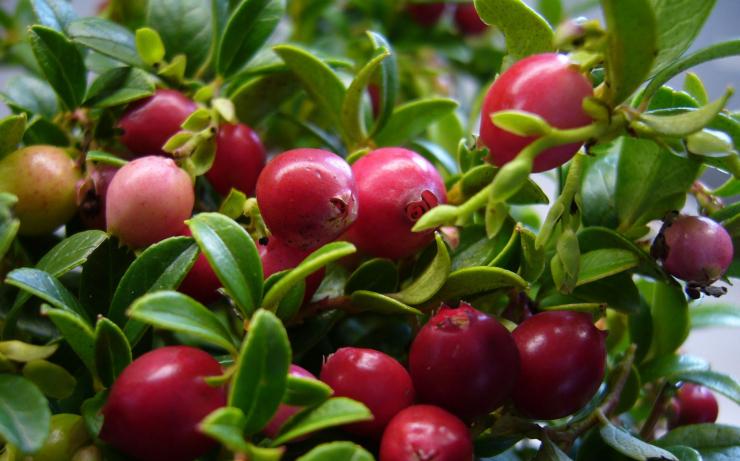

Botanical description
Let's see what a lingonberry looks like. It is an evergreen shrub of the cowberry family, reaching a height of about 30 cm.
It has a creeping rhizome that can grow up to 18 meters and is capable of putting down thin, short roots that form mycorrhiza with fungi.
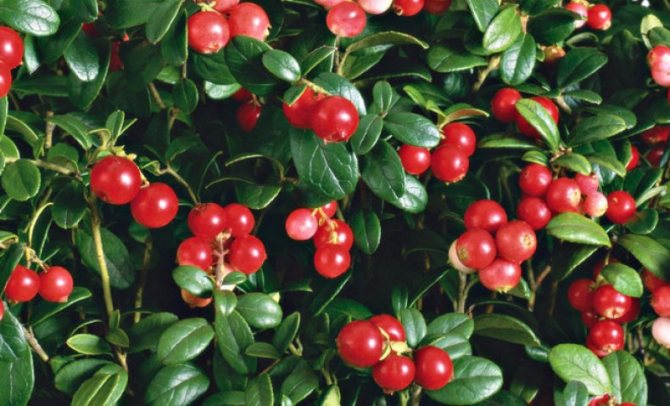

Leaves are dense and leathery, dark green on the upper side and light green on the bottom, not pointed at the apex. The edges of the leaf blade are slightly bent downwards.
Drooping clusters of 10-12 white-pink, bisexual flowers form lingonberry inflorescences, which have a light pleasant aroma. Insects pollinate them. And flowering begins in late May or June and lasts about 14 days.
The fruit is spherical, red, up to 8 mm in diameter, has a sweet and sour taste, has a lot of semi-lunar brown seeds, which look shiny. Wild lingonberry begins to bear fruit at 14-20 years old, garden - at 5-10 years old. The fruits ripen in late summer or early autumn.
Read also: The benefits of marijuana: the medicinal uses of the plant
Popular varieties of lingonberry
Almost every year, breeders present to fans of lingonberry new varieties that are distinguished by fruiting and endurance. Some of them have already gained recognition from gardeners, among them:
- Coral. A high-yielding variety, which is distinguished by a compact bush (only 30 cm), a beautiful shape (spherical). Coral blooms and bears fruit twice a season.
- Ruby. A variety that tolerates low temperatures with ease. Fruiting abundantly, the berries have a pleasant sweet and sour taste.
- Red Pearl. Shrub lingonberry grown for bountiful harvests. It blooms twice a year, with the correct introduction of nutrients, it gives a full harvest.
- Kostroma pink is another variety worthy of attention. The height of adult plants is up to 15 cm. Fruiting occurs in August.
Lingonberry is a plant that will not cause trouble even for a novice gardener. It is enough to study the requirements of the bushes once, so that caring for them turns into a pleasure. For the labors, the lingonberry will certainly thank you with delicious and healthy fruits.
Choosing a landing site
Although lingonberry cultivation does not have many requirements, suitable conditions must be created in the garden in order to obtain good growth and yields.
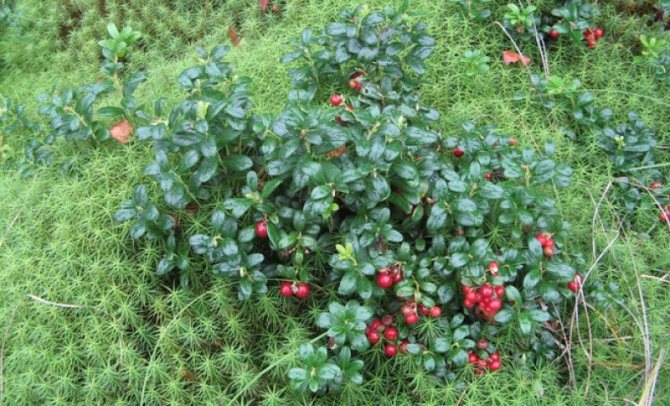

Wild lingonberry is able to grow in the shade of forest trees, not particularly needing sunlight. But the garden will not give a good harvest if it is in a shaded area.
Soil for lingonberry
Lingonberries are suitable for loose soil, with an acidity of 4.5-5, 5 pH, moist and moderately lit, therefore, it is better to prepare separate, non-darkened beds for growing in the garden.
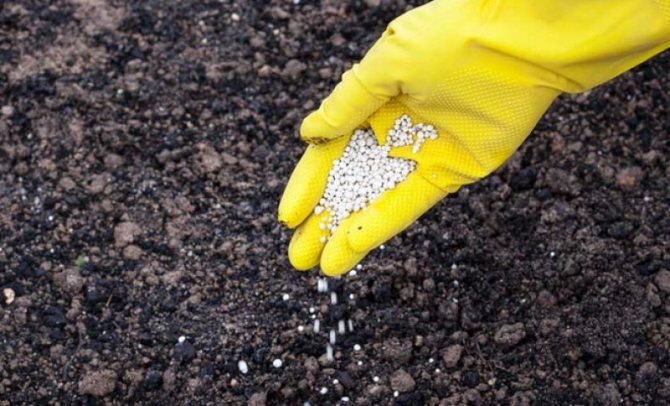

If the soil is quite dense and heavy, remove 20-25 cm of the top layer. A combination of peat and sand, taken in equal parts, must be poured into the dug pit, and if the site is located on a former peat bog, then sand the ground with a depth of 13 cm.
Neutral soil should be mixed with needles, which will acidify it during self-decomposition. When planting, lingonberries are not fertilized with humus and compost. But in each soil mixture, you can add 10-15 g / sq. m of sulfur and mineral fertilizers. Also, 20-25 g / sq. Is added to the top layer. m of double superphosphate and 15-20 g / sq. m of potassium sulfate.
How to independently prepare soil for planting
The correct composition of the soil is the key to successful cultivation of garden lingonberries. For a plant, the fertility of the substrate is not so important as its acidity. The berry grower does not tolerate heavy loam, but prefers loose light loam, sandy loam and peaty soils. Sandy soil is considered ideal.
If the soil is slightly acidic or neutral, it will have to be acidified regularly by adding powdered sulfur at the rate of 10-15 g / m2. You can use acidified water - dilute 100 g of citric acid in 3 liters of liquid or mix 20 ml of apple cider vinegar with 1 liter of water. For watering 1 m2, you need to use 10 liters of solution.


You can acidify the soil with water and citric acid
Planting a plant
First of all, the area must be leveled so that there are no pits and depressions.


The fact is that if water stagnates in them during frosts in late autumn, this can lead to damage to the peduncles or, in the worst case, to the death of the plant.
Landing dates
The most suitable season for planting lingonberries is spring. In summer and autumn, survival rate is much lower.
Technology and circuit
To plant individual lingonberry shrubs, use the tape method. The width of the tape is 80 cm. The row spacing is 40 cm. Lingonberry grows quite quickly and fills the maximum free space, so sometimes it is necessary to thin it out. Planting 1-3 year old seedlings is in the grooves of 7-8 cm.The distance between the bushes is 30 cm.
Shrub care rules
- Avoid waterlogging.
- Remove weeds from the soil during the warm season.
- Thin out dense young growth with a pruner.
- If the temperature drops below -3 ° C during flowering of lingonberries, it should be covered with spunbond or agril.
- The soil around the lingonberry needs to be loosened in the summer season.
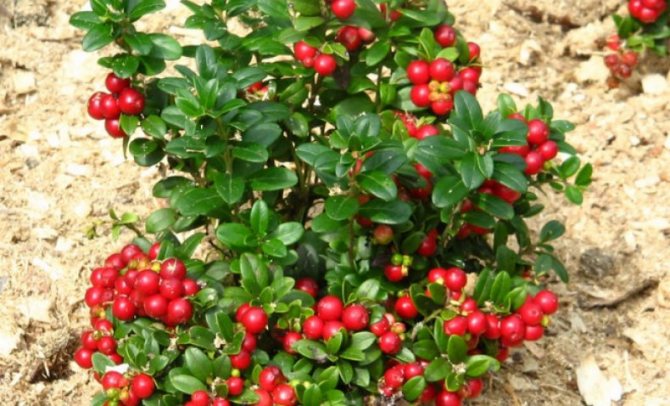

Watering and soil care
It is best to use drip irrigation or hand irrigate it twice a week. The main thing is to observe the "golden mean" between drying out and waterlogging.
Over time, water reduces the acidity of the soil, so you can organize acidification of the soil every three weeks. Lingonberry cultivation also requires soil care. It needs to be loosened in a timely manner, get rid of weeds, and periodically mulch.
Mineral fertilizers are applied in small quantities during the fruiting period - 1 tbsp. spoon 10 sq. m... Top dressing is best done in spring or early summer.
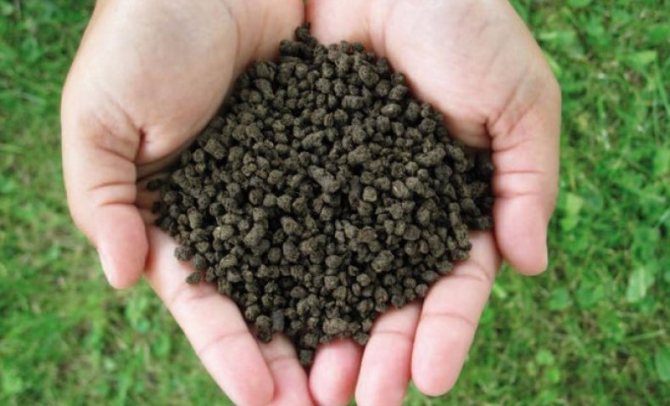

For this, you can use superphosphate 30 g / sq. m, ammonium nitrate (30-40 g per 10 liters of water). Also, special preparations for heather are used, such as "Solution" and "Kemira".
When the age of the lingonberry bush reaches seven years, it is rejuvenated pruning, leaving a shoot 4 cm long.It will begin to bear fruit again in a year. Pruning should be done in early spring, when the juices in the plants have not yet begun to move.
Is shelter required for the winter
The opinions of gardeners boil down to the fact that in most cases, lingonberry shelter for the winter is not required. This berry grew and multiplied in the cold North, so it is obvious that it can withstand frosts and snowless winters.
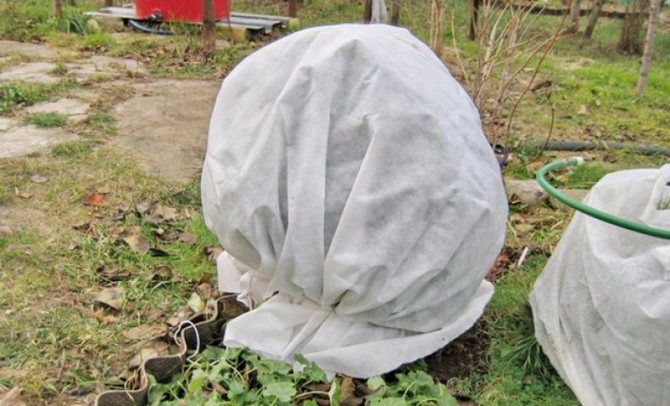

True, when it blooms, a sharp and significant drop in temperature, for example, when frosts return in early spring, can destroy the future harvest. Therefore, you can cover lingonberries overnight with lutrasil or other non-woven material.
Recommendations for planting and caring for garden lingonberries
Many berries, which are considered forest, can be grown in the suburban area. Garden lingonberry is no exception, planting and caring for which have several features. Moreover, its cultivation will not be particularly difficult. The main thing that needs to be done is to create conditions close to those in the natural environment of berry growth.
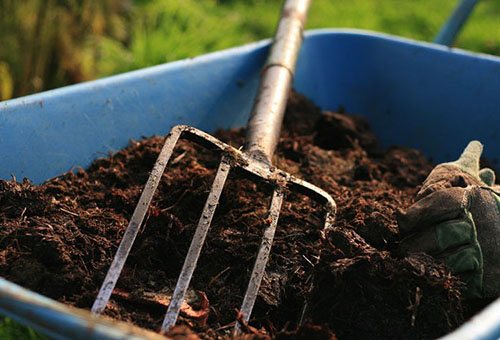

Soil preparation
Under natural conditions, lingonberry grows in raised bogs. The soil there is constantly moist and loose, and besides, it is very acidic. Accordingly, the same conditions must be created for growing this berry in a summer cottage. To make the soil more acidic, you can use a vinegar solution or ground sulfur.
Lingonberry loves sunny, well-lit places. And, despite his love for a humid climate, he does not tolerate excess fluid.
It is best to plant lingonberries in peat soil. However, if there is no such land in the garden, you can create a suitable nutrient medium artificially. To do this, you need to dig a ditch at the site of the future planting. It should be about one hundred and twenty centimeters wide and about thirty deep. After that, the resulting trench is filled with a mixture of soil:
- for clay soil - three parts of peat and one part of coarse sand;
- when the soil is very loamy, more sand is added to a ratio of 3: 2;
- for sandy soil, peat is mixed with garden soil in the same ratio. In this case, you can also replace the peat with forest litter, but then you need to take an equal amount of ingredients.
Read also: Growing Lavater at home
Next, you need to slightly compact the resulting bed. If groundwater flows near the place where the lingonberry will be grown, drainage should also be added to the bottom of the ditch. In this capacity, you can use, for example, crushed stone, broken brick, gravel or small pebbles.
After that, the soil for planting is almost ready - all that remains is to feed it. This is done with the help of mineral fertilizers - ammonium and potassium sulfates, as well as superphosphate. It is important not to overdo it with fertilizers, a large amount of them harms the plantings of lingonberries.
Organic fertilizers, especially manure, must not be added to the soil under the lingonberry, as they increase the alkali content in the soil. In addition, the applied dressings must be free of chlorine.
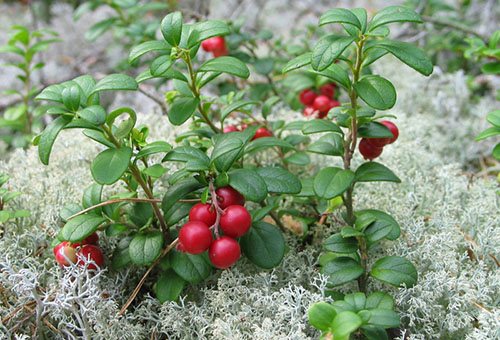

Reproduction
Under natural conditions, lingonberry reproduces in a generative way - by seeds. But growing it in this way in the garden is not very convenient. To ensure that a bush grows from a seed is quite problematic, and that it is also fruitful is almost impossible. In addition, it will take a long time to wait for the appearance of the berries.
Therefore, in summer cottages, as a rule, lingonberries are propagated by vegetative methods. There are three of them.
When multiplied by one of these methods, it will be possible to get a crop within a year or two after planting. The fastest results are obtained by dividing the bush.
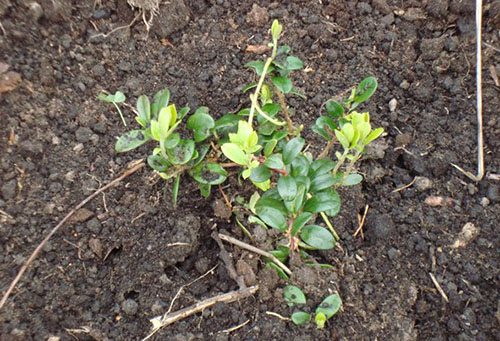

Cuttings or pieces of rhizome are planted in a previously prepared place in the spring - in April or the first half of May. There is also information that you can start growing in the fall, but in this case, the planting material must be grown in advance at home.
The depth to which shoots should be buried is about six to eight centimeters. Disembarkation is done in a line or in rows. The distance between the bushes should be at least thirty centimeters, and between the rows - about sixty. Further, the seedlings must be watered abundantly.
After planting and watering, it is recommended to sprinkle the soil with sawdust, pine needles, sand or cover it with bark.This process is called mulching.
The next stage of planting, necessary for the bushes to take root and take root in a new place, is the shelter of young shoots. For these purposes, burlap, polyethylene or some other similar material is used. In order not to dry out the soil and avoid burns on the plants, you should additionally cover the transparent material with old newspapers or gauze. Covering material is removed after three weeks.
Lingonberries can grow not only horizontally, creeping along the ground, but also vertically. If you put special supports, then the bushes can stretch up to a meter.
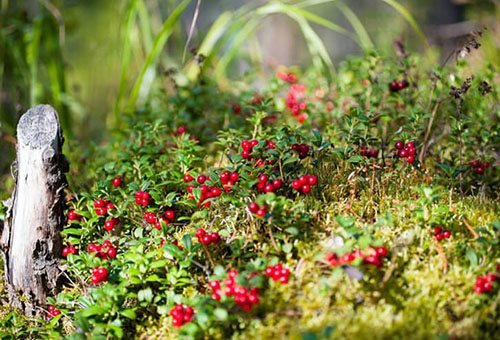

Cultivation of lingonberries does not require any special care measures, only standard activities, as for any other crop. These are regular watering, weeding and mandatory loosening of the soil. Watering is necessary as the soil dries up, but do not overdo it. As a rule, in the absence of rain, watering frequency is about once a week. In extremely hot, dry weather, it is also necessary to spray the leaves every couple of days.
After three years, the plantings become more dense. From this moment on, you need to start feeding them. This is done with the same fertilizers that were applied during planting. Also at this time it will be necessary to thin out the shrubs. The removed plants can be used as fertilizer for other crops or planting material.
When the bushes are ten years old, they will need to be cut. As a rule, the lower old branches are removed. This should be done in early spring - in the first half of March. Carrying out such activities will increase the life span of the old bush and contribute to the formation of new shoots.
Lingonberry is a frost-hardy plant, and usually there is no need to cover it with anything for the winter. The exception is very cold winters, during which little snow falls. In this case, it makes sense to cover the bushes with burlap or some similar material. This will keep the underground parts of the plant from drying out.
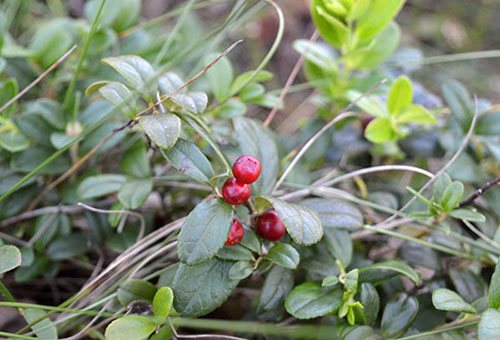

HOW TO BREED LIVING
Purchased varieties can be propagated by cuttings. To do this, after the bush has grown enough, you need to carefully separate the part of the shoot, which has roots, and plant it in a new place. You can do this literally the entire warm season, the main thing is to do it quickly: you dug it up and planted it either in the soil or in a container with soil, because the roots of the lingonberry dry very quickly.
As soon as the lingonberry grows - after four or five years, it may need protection from the north wind. It is simple to do this: it is enough to plant, say, shrubs with a dense crown, such as alder-leaved irgi, from the north side. It is also interesting that in the absence of a gusty cold wind, a minimum of moisture evaporates from the soil surface, therefore, plants can be watered less often. And during the ripening period, the absence of wind allows the berries to form a wax coating on their surface, which is why they are stored longer.

